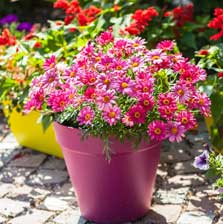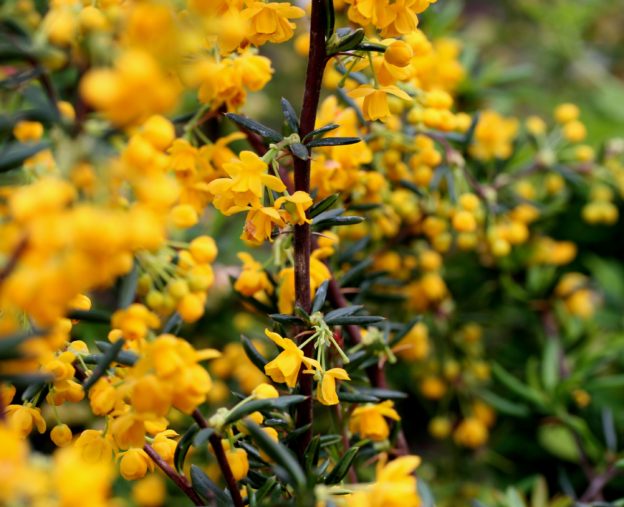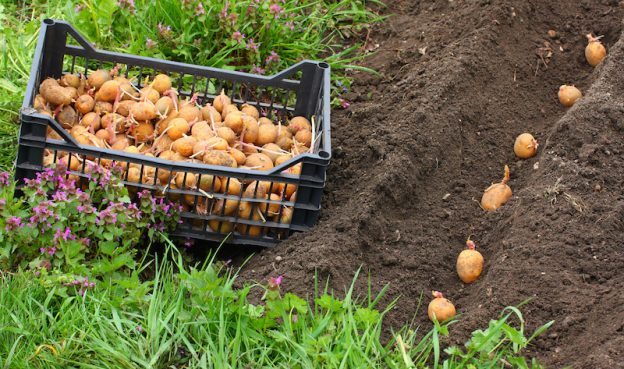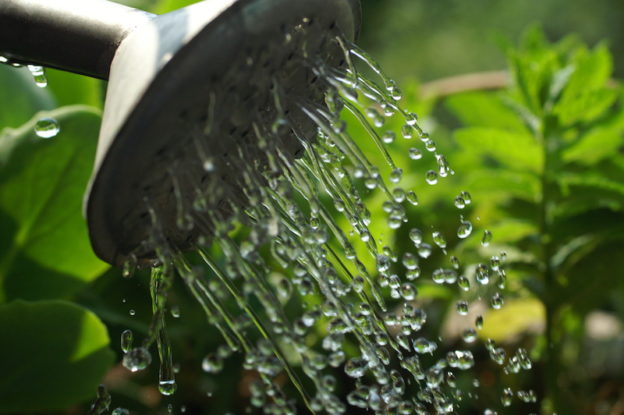Want to get the best from your garden? Check out our top tips for what to do this August.


With all the benefits that come with living on the coast, there is also the curse of strong winds and salt spray which could hamper your efforts in the garden. However, coastal gardening is not impossible. By understanding the challenges that you are facing and working around these a beautiful garden can be created to flourish even in the tricky conditions.
This is probably the most fundamental step in designing a successful coastal garden. Protecting plants from the extreme winds will prevent leaning, abrasion or breaking and allow you to grow more delicate plants. Trees, hedges, shrubs or man made structures will work ideally as a windbreak. It is important to identify the general direction of the wind to erect your shelter in the right place and avoid causing a wind tunnel! A good windbreak will be reduce wind for a distance of 10 times of it’s height. If you are growing your own windbreak it will take time so be patient. You can help along your own windbreak with a shelter such as a mesh screen, netting or woven willow.
Good plants for shelter;

Cordylines are good plants for shelter.
Trees; pinus radiata, escallonias, pittosporums
Shrubs; berberis, pyracanthas, buddlejas
Lower plants are much more likely to flourish as the wind will hopefully go over them. Planting in masses with many plants of similar heights can also look great.

Berberis are good shrubs for shelter and colour in a coastal garden.
Once you have sheltered your garden you can start to add the colour and interest with perennials such as these;
Agapanthus, achillea, lupins, geranium (hardy), kniphofia, hemerocallis, papavers and many more. Ask our experts in store for more advice.
Coastal soil is known for being nutrient poor and extremely free draining meaning that water retention can become a problem. Mulching the garden soil with the right materials can solve this. Use flint, gravel or grit to mulch and also add nutrient rich dressings such as compost, manure or even rinsed seaweed!
With the evaporation caused by the seaside wind it can be hard to water and plant at the right time. Along with regular watering once in a while it is good to water from above; although this is often discouraged, on the coast it means that you get rid of the salt buildup to prevent salt burn. Also mulch to trap the water. In autumn you should plant any trees and large shrubs in the warm soil to allow them to establish with the winter rains. In spring smaller plants should be planted as their vulnerability means that they need a whole growing season to establish- take care to keep them moist during this season though!
The most important thing is to love your coastal garden for exactly that! There is no point trying to turn a garden on the coast into a prim and proper country garden with a perfect lawn and roses. Appreciate the surroundings and take inspiration from them; add some shells, some rope, some driftwood, pebbles and create an interesting and unique coastal garden.
All plants have different needs with regard to composts. There are many specific types of composts that fulfil the criteria of what you are growing, however, multipurpose composts can often be adapted to work similarly. This compost guide will work through the common plants, the properties of compost that they need and how to modify multipurpose compost to do a similar job.
Seeds need a fine compost to help roots spread out and with holding water properties, however not so fine that the water holding becomes water logging. It is best to put this fine compost in tiny cell seed trains.
Adapting multipurpose compost; sieve the compost to remove any coarse lumps and make it finer, also add vermiculite which is a fine particle that helps to keep roots healthy by letting air into the root zone.
To grow cuttings
You need a free draining and coarse growing media here.
Adapting multipurpose compost; to ‘open up’ compost is to make it more free draining by increasing the porosity of it. This can be done by incorporating coarse ingredients like coarse grit or perlite.
To grow house plants
A good balance of drainage is needed for house plants. Drainage that is too free can lead to the plants drying out however if the drainage isn’t free enough then accidental overwatering can easily kill the plants. There are numerous specialist composts in this area and many designed for set sub groups like cacti or orchids (see below). Luckily they all come in small bag sizes perfect for 1-5 plants.
Adapting multipurpose compost; the best combination for house plants is a ratio of 80:20 of a peat substitute or peat to perlite. Also add some fertiliser and ground limestone too.
 They need a very free draining media because they are not specially adapted to living in soil and their roots are hugely sensitive to water logging. Naturally they live in the branches of trees so the best mixes are actually very chunky.
They need a very free draining media because they are not specially adapted to living in soil and their roots are hugely sensitive to water logging. Naturally they live in the branches of trees so the best mixes are actually very chunky.
Adapting multipurpose compost; to create this really coarse media you can add bark and even pieces of synthetic sponge to your multipurpose.
 These require both good aeration and good drainage. Using fine compost here does not work because it is left for a long time, over this time the finer materials decompose and settle which is known to close air spaces and cause disease or even drown the roots. This is easily prevented by adding in coarse ingredients and loam.
These require both good aeration and good drainage. Using fine compost here does not work because it is left for a long time, over this time the finer materials decompose and settle which is known to close air spaces and cause disease or even drown the roots. This is easily prevented by adding in coarse ingredients and loam.
Adapting multipurpose compost; open up the compost with bark chips and also add lime and fertiliser. In this case, it may be best to go with John Innes compost which will be much easier. You can buy multi-purpose compost with added John Innes.
 This is where you don’t really need to adapt the multi-purpose compost. It does the job nicely, however you may wish to add some water retaining crystals so the compost does not dry out too quickly.
This is where you don’t really need to adapt the multi-purpose compost. It does the job nicely, however you may wish to add some water retaining crystals so the compost does not dry out too quickly.
 You need an ericaceous compost for these plants.
You need an ericaceous compost for these plants.

We often hear the phrase ‘Earthing up’ whilst speaking about potatoes, especially around this time of the year. It is much simpler and more useful than it may sound!
Earthing up or ridging as it is sometimes known, is simply drawing up soil into a ridge above the row of planted potatoes. You can do this as soon as foliage emerges above the surface.
Maybe you have decided to grow potatoes in sacks or containers, if so the process of earthing up still applies- simply add layers of compost in stages as the stems begin to grow. Carry on until you reach the top of the container. A good heap of about 8 inches / 20-cm should be enough.
After all your efforts with earthing up, don’t give in to the temptation of harvesting your crops too early. For early potatoes be sure to wait until the flowers are completely out and for the main crop variety you can hold back until the foliage begins to turn yellow.
Originally from South America, tomatoes tend to prefer a warmer climate and suffer when the temperatures drop below 10°C. Consequently, take care not to plant your tomatoes outdoors too early. This will prevent a number of problems such as catfacing (malformation and scarring of the fruit), brown leaf spots and leaf curling. A tomato plant can usually survive these issues and recover in the warmth. However, if it was a surprise frost that caught your tomatoes then the damage is usually permanent and it is best to start over.
For best results we recommend covering the tomatoes until you are sure that the weather will be warm enough. A great indicator for this is usually when the temperature remains above 10°C overnight, so buy yourself an outdoor thermometer to check when you next pop in to one of our garden centres. Next, choose the warmest spot possible in your garden. Ideally keep your tomato plants in a greenhouse or plastic grow-house. Make sure that the spot is also aerated and a fair distance from your potatoes because blight can travel and flourishes in humid conditions. Another option to try out is planting your tomatoes in pots in the sunniest part of your terrace or balcony for great fruit and decoration!
After planting;
Feeding tomatoes should start after the first truss (stem with small green fruits) has set in. We recommend the product Tomorite as it has been a gardener’s friend for decades. It is ideal for other plants too including flowering plants due to the high potash content. It contains seaweed extract which supplies many micro-nutrients and produces full flavoured tomatoes. Outdoors you feed every 7 days, in a greenhouse feed twice a week.
Start picking when fruit is ripe and fully coloured. At the end of the growing season if you have some green tomatoes still on the plant, we recommend this delicious green tomato chutney recipe.
We sell numerous tomato varieties throughout the growing season available in batches as they are ready from the greenhouses. Without a doubt our top selling varieties year on year are;
Gardeners Delight: a flavoursome cherry tomato known for heavy crops and great to grow in tomato bags or pots.
Shirley: an early maturing tomato that is known for heavy crops and also shows excellent disease resistance. Ideal for growing in a growbag or as a greenhouse cordon.
Moneymaker: grown as a cordon (vine) this variety produces smooth, medium salad tomato sized fruit that are delicious in flavour.
Tomatoes are often treated as a vegetable in cooking and in deed our classification on the garden centre beds. However, the tomato is actually a ![]() fruit since its seeds are inside.
fruit since its seeds are inside.

Saturday 17th March is St Patrick’s Day and we love all things green. Our Sidmouth Road team have turned into Leprechauns and discounted lots of items across the store.
Can you find the lucky clovers? Find the clover, find the bargain. Clovers are hidden around our garden centre. In addition, we will have
25% off all bulbs
25% of all seed potatoes and
25% off selected watering cans.
There will also be a special Irish menu in our 1925 Kitchen. Choose from either a
St Patrick’s Beef & Guinness Stew at £7.95 or
Homemade Leek and Potato Soup with fresh baked roll and Irish butter £4.50
This event is taking place at our Sidmouth Road, Clyst St Mary garden centre, Exeter on Saturday 17th March 2018.

It’s July, time when the roads get busier with holiday makers and time to retreat to the sanctuary that is the garden.
When it is warm, continue to hoe weeds, as they will shrivel and die on the surface. Likewise, if you see any larvae or adult pests pick them off, squash them or use a suitable control method. Scarlet Lily beetles are particularly a pest at this time of year.
If you have any variegated shrubs, cut out any non variegated branches, making your cut at the base of the stem where it joins the main trunk. Many variegated shrubs will try and revert to their mono colour if not managed in such manner.
Prune deciduous magnolias if required but always leave at least 75% of the original canopy.
Prune your early flowering shrubs like Weigela taking them back to well placed side shoots.
Cut back hardy geraniums after flowering to encourage them to re-flower or grow fresh foliage.
Continue to harvest rain and use your water butts to water plants like agapanthus, camellias and rhododendrons as they will be setting their buds for next year.
You should also water clematis, roses, laurel and honeysuckle in dry weather to discourage powdery mildew.
For more advice on what to do in your garden at this time of year, come and speak to one of our plant team who will be pleased to advise.